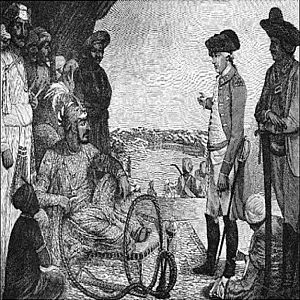Battle of Buxar facts for kids
Quick facts for kids Battle of Buxar |
|||||||
|---|---|---|---|---|---|---|---|
 The Mughal Emperor Shah Alam II, as a prisoner of the British East India Company |
|||||||
|
|||||||
| Belligerents | |||||||
|
|||||||
| Commanders and leaders | |||||||
|
|||||||
| Strength | |||||||
| 40,000 140 cannons |
7,072 30 cannons |
||||||
| Casualties and losses | |||||||
| 10,000 killed or wounded 6,000 captured |
1,847 killed or wounded | ||||||
The Battle of Buxar was a very important fight in Indian history. It happened on October 22 and 23, 1764. The battle was between the British East India Company and a group of Indian rulers.
The British forces were led by Hector Munro. The Indian side was a combined army. It included Mir Qasim, who was the Nawab (ruler) of Bengal. It also included Shuja-ud-Daula, the Nawab of Awadh. Finally, the Mughal Emperor, Shah Alam II, was also part of this alliance.
The battle took place near Buxar, a town in Bihar. Buxar is located on the banks of the Ganga River. The British East India Company won this battle. This victory was very important for them. The war officially ended with the Treaty of Allahabad in 1765.
The Battle Begins
The British army had about 7,072 soldiers. This included 1,859 British soldiers. The rest were Indian soldiers called sepoys. They also had Indian cavalry.
The combined Indian army was much larger. Some reports say they had about 40,000 soldiers. Other sources suggest even more.
Despite their large numbers, the Indian allies faced a big problem. They did not work well together. This lack of teamwork was a major reason for their defeat.
Mirza Najaf Khan led the right side of the Mughal army. He was the first to attack the British. Major Hector Munro quickly got his British soldiers ready. They stopped the Mughal attack.
Some cavalry from the Durrani and Rohilla groups also fought. They had several small fights during the battle.
Key Moments and Retreat
By the middle of the day, the battle was mostly over. Shuja-ud-Daula destroyed his gunpowder supplies. He also blew up three large storage areas for gunpowder.
Munro divided his army to chase the retreating forces. He especially went after Shuja-ud-Daula. Shuja-ud-Daula crossed a river and then destroyed his boat-bridge. This left the Mughal Emperor Shah Alam II and his own soldiers behind.
Mir Qasim also ran away. He took valuable gemstones with him. He later died without money in 1777.
Mirza Najaf Khan tried to reorganize the soldiers around Shah Alam II. However, Shah Alam II decided to retreat. He then chose to talk with the British.
The British won a lot from this battle. They captured 133 cannons. They also took over 1 million rupees in cash.
After the Battle
The British victory at Buxar changed a lot in India. It weakened the power of three major Indian rulers.
Mir Qasim disappeared and lived a poor life. Shah Alam II surrendered to the British. Shah Shuja (Shuja-ud-Daula) fled west. The British chased him. He eventually surrendered too.
By 1765, the British had become very powerful. They were almost the rulers of Bengal, Bihar, and Orissa. Robert Clive became the first governor of Bengal.
Even after this big win, the East India Company faced money problems. They were almost out of money. This made the British government try to make changes to how the company worked.
Images for kids
-
The Mughal Emperor Shah Alam II, as a prisoner of the British East India Company, 1781
-
The Nawab of Bengal, Mir Qasim
-
Shuja-ud-Daula served as the leading Nawab Vizier of the Mughal Empire, he was lifelong of Shah Alam II.
-
Mirza Najaf Khan Baloch, the commander-in-chief of the Mughal Army.
See also
 In Spanish: Batalla de Buxar para niños
In Spanish: Batalla de Buxar para niños






